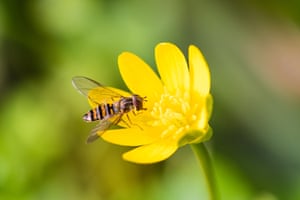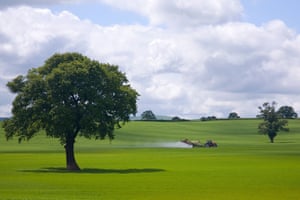For eight hours a day, from March until May, research biologist Will Hawkes surveys huge swarms of insects landing on the Karpaz Peninsula on the north-east corner of Cyprus. “This place is a migratory hotspot for millions of painted lady butterflies, drone fly hoverflies, seven-spot ladybirds and vagrant emperor dragonflies – it’s like nothing I’ve ever seen before,” says Hawkes, a PhD student at the University of Exeter’s Genetics of Migration lab who first studied the phenomenon here a year ago.
“This island is a pit stop for millions of insects that fly at high altitudes over the sea then come to land to rest as they migrate, possibly thousands of kilometres from the Middle East to western Europe. It’s just astonishing that these creatures migrate such long distances and in such vast numbers in order to find the right food to eat and to reproduce in environments at particular temperatures,” he says.
“One grass fly we found at Cyprus is just 2mm long, so, for their body size, these migrations are quite incredible. Most of the time they’re completely invisible to us,” adds Hawkes, who explains that the distances travelled by insects flying via Cyprus are as yet unknown. The furthest insect migration recorded is the 18,000km journey of the 4cm-long globe skimmer dragonfly between India and Africa.
Hawkes’s PhD supervisor, Dr Karl Wotton, describes his research at Karpaz as significant. “Migration hotspots like this are a window into processes that normally go on unseen, high above our heads, as huge amounts of insects make seasonal movements,” says Wotton. “This Cyprus hotspot shows how distant ecosystems can nevertheless be connected. It’s part of an emerging global picture of insects on the move.”

Hawkes collects insects flying along a gully using a butterfly net in a “Victorian-style study”, then puts them into an insect cage to identify the species before releasing them. He also sets up tiny cameras to record insects flying past for timed periods at set intervals – back in the UK, he spends weeks manually counting the numbers in every shot, frame by frame.
“We can record thousands of insects flying past per minute – it’s a big challenge,” says Hawkes who, by returning annually, is building a long-term data set to let scientists observe trends and patterns over time. “Some butterfly, dragonfly and hoverfly migrations have previously been studied but very few studies look at the bigger picture of insect migration. There are huge gaps in our knowledge; we’re genuinely at the very beginning of understanding these insect migrations.”
Radar studies show that 3.5 trillion insects (3,200 tons of biomass) migrate annually above southern Britain alone, as published in the journal Science. “Many of these insects are key pollinators and play a major role in pest control, so they’re absolutely vital to agriculture simply due to their sheer numbers,” says Hawkes. “Flies are the most numerous migrants and they have such an enormous impact on the biodiversity of our ecosystems and pollination of crops and plants.”

In July 2019, Wotton, a senior lecturer at Exeter, revealed in the journal Current Biology that 1-4 billion hoverflies migrate into and out of southern Britain each year. As larvae, these hoverflies consume 3-10 trillion aphids, a species that would otherwise be damaging to crops. As adults, hoverflies eat nectar and pollen and are second only to bees in terms of their importance as pollinators.
Wotton recorded that migrant hoverflies each carry on average 10 grains of pollen, flying up to 100 miles a day. By transferring pollen between different populations of plants as they travel, migratory insects help maintain a diverse gene pool for wild plants and crops, increasing resilience to changes in environmental conditions and the effects of climate change.
Remarkably, insects are multigenerational migrants – one full circuit involves between three and six generations of adults moving north from springtime to late summer, followed by one generation travelling back south during the autumn migration. The adults die once eggs are laid, before larvae hatch, so these long-distance migrations are not learned behaviours. “These migrations are purely genetic. Insects use the sun as their compass and only migrate on days when the winds are favourable,” says Hawkes, who also surveys insects flying along the valleys in the Pyrenees mountains on their autumn migration south. “It’s also likely that when a huge volume of adults dies at the end of each leg of the journey, their biomass provides a seasonal input of nutrients in each location which could be a key food source for other species.”
But with plummeting insect populations, conserving biodiversity has never been more crucial. A global review published in the journal Biological Conservation found that more than 40% of insect species are declining and a third are endangered.
Q&A Why do insects matter to humans?
Show
Hide
Insects are crucial to the health of functioning ecosystems that are vital for food production and security. Pollinators like bees get a lot of attention because three quarters of crops producing fruit and seeds for human consumption depend on them, according to the Food and Agriculture Organization. Other types of insects include herbivores, detritivores, parasitoids and predators that are crucial to ecosystems humans rely on to survive, acting as pest controllers, recycling nutrients and performing other tasks.
How do humans harm insects?
Habitat loss and fragmentation, pollution, invasive species, the climate crisis and over-harvesting are all human-caused issues that put pressure on insects, say experts. The heavy use of synthetic pesticides and fertilisers is the primary driver of harm to insects by humans, according to the first global scientific review of the literature in 2019.
How bad is it?
Bad. Insect populations around the world are plummeting, with 40% of species declining and a third endangered, according to the same literature review. On average, insect biomass on Earth has fallen 2.5% a year for the last three decades or so, which could mean they vanish within the next 100 years.
What happens if insects become extinct?
The survival of mankind would be at stake. With no insects to pollinate the crops humans rely on to eat or perform vital functions in ecosystems, humans would be in trouble.
What can we do about it?
Insect experts have devised a roadmap for conservation and recovery. In the short term, humans must phase out pesticide use, prioritise nature-based farming methods and reduce light, noise and water pollution. In the long term, scientists have called for an international body to monitor the health of insect populations and action taken to help them.
“Migratory insects are vulnerable to habitat loss beyond the boundaries of one country, and climate breakdown could affect the migration routes and ranges of these insect species so we need to take a more global, holistic view of conservation,” says Hawkes, who believes farmers can make an enormous difference by reducing the use of pesticides and leaving field margins to grow wild.
“It’s easy to see the difference in numbers of insect types between a patch of wildflowers at the edge of a field and the middle of a crop – we need to move away from monoculture towards agro-ecology.”

Matt Shardlow, chief executive of invertebrate conservation charity Buglife, warns that spray drift and soil transport of pesticides into field margins pose a risk and that wildflower-rich habitats should be prioritised in urban areas, on road verges and railways, away from crops sprayed with pesticides.
“We’re restoring wildflower grassland to increase the availability of pollen and nectar for dispersing wild insects along a network of insect pathways called B-Lines throughout the British countryside and towns,” says Shardlow, who is keen to persuade the authorities and EU partners to roll the network out across Europe.
“These B-Lines will enable better dispersal of migrants and enable more species to start dispersing north again – something that’s prevented by increasingly fragmented habitats and the polluted nature of intervening land.”
On an international scale, further research is required before the science of this Cyprus migration hotspot can influence policy and conservation management. “We need further understanding of the biology of the species involved, natural variation in numbers and the routes taken before any strong recommendations can be made,” Wotton says.
“Conservation of entire migratory tracks takes collaboration between farmers, conservationists and politicians,” Hawkes adds. “We need to think beyond borders and consider how habitats link together along these migratory routes.
“At an international level, we need politicians to realise that insects are playing a vital role so that governments create consistent policies that protect the diversity of insects and the plants they rely on.”
Find more age of extinction coverage here, and follow biodiversity reporters Phoebe Weston and Patrick Greenfield on Twitter for all the latest news and features